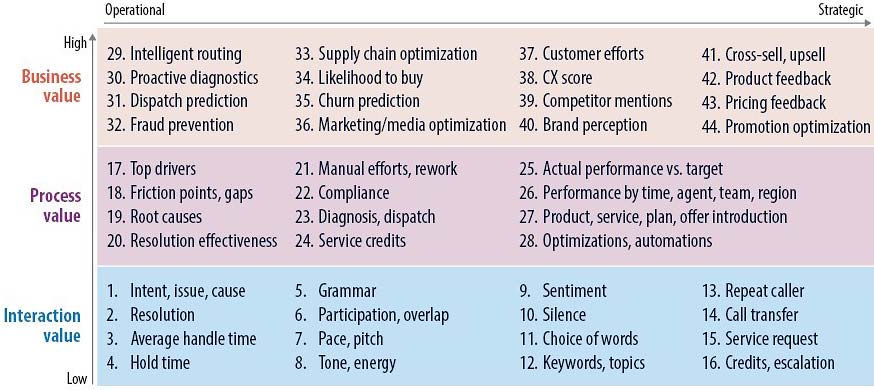Insights
- Contact centers still deal with dissatisfied and disengaged workforce — primarily due to the lack of efficient tools that empower agents with right knowledge and behaviors.
- Most companies measure customer experience and agent effectiveness through metrics such as net promotor score and average handle time, while leaving the goldmine of call recordings largely untouched.
- AI-based contact center management systems can resolve this problem. They can automatically analyze voice data to generate insights that can detect a customer issue in its infancy.
- AI-based systems help agents access holistic customer data, generate real-time transcriptions for smoother transfers, understand customers’ tone and intent, and identify learning requirements.
- These capabilities significantly improve agent experience, paramount to better customer experiences.
- With such systems, contact centers can get timely customer insights, saving the cost of managing calls for identified issues and optimizing product offerings.
Organizations invest substantially in customer relationship management systems to build a seamless customer experience (CX) through a 360-degree customer view. However, the adoption of AI is largely limited to chatbots and has yet to deliver desirable human-machine conversations. Only 9% of customers are able to resolve their queries via self-service options, says Gartner.1
Most contact center agents are disengaged and do not have efficient tools or training to have an impact on CX.2 To fix this, the focus should be on agent experience (AX) — implementing tools that make agents more empowered, educated, empathetic, and efficient. This shifts the emphasis from cost savings to value generation, ultimately leading to happy and loyal customers.
Hurdles to agent empowerment
The biggest factor hindering agent empowerment is contact centers’ inability to effectively use call recordings for “training and quality purposes.” A poll conducted by Infosys among 40 contact centers revealed that none of these centers ever revisited their recordings. Even if they chose to do so, they were required to pay a fee to their service provider, which becomes very costly at scale.
Contact centers haven’t been able to leverage their call recordings effectively thereby hindering agent empowerment
Most contact centers use only post-call satisfaction surveys, which rarely reveal the core customer problems. Many times, agent effectiveness suffers due to manual processes, inconsistent or inaccurate knowledge, and different applications for every need. Further, classroom-oriented training is counterproductive for an industry whose workforce comprises 87% millennials, Generation X, and Generation Z — the digital natives.
It is becoming increasingly difficult for contact centers to hire, train, and manage agents in the pandemic-induced remote working environment. From 4% of agents working from home prior to the pandemic, the situation reversed to 96% of agents at home after the lockdowns came into force. This has made monitoring even harder, with one supervisor listening directly to calls taken by 15 agents on average. Going forward, around half of the agents are expected to continue working from home, with the hybrid model gaining prominence globally.
Switch to an AX-focused mindset
Contact centers need to focus on customer success and equip agents to deliver that.
The performance of a contact center is predominantly measured by its cost effectiveness (how many calls it can handle), which is understandable, given the sheer volumes. A Fortune 200 company can receive 100 million to 200 million calls each year. The standard metrics include average abandonment rate, handling time, occupancy rate, first contact resolution, and post-call feedback or net promoter score (NPS). However, these measures reflect throughput more than the agents’ ability to deliver customer success.
In an AX-focused model, agents must be well equipped to deliver customer success in every interaction. For instance, customer data should be quickly accessible to avoid putting customers on hold while information is fetched. Agents must know how to predict customer intent to create a positive outcome. Most importantly, agents should be given high-value tasks and better career opportunities to ensure a healthy mental state.
An AX-focused contact center requires significant investments in people, processes, and technology, and comprises the following:
- Creating a culture of autonomy, alongside accountability and compliance.
- Emphasizing customer resolution over metrics such as average handling time and NPS.
- Upgrading to an automation-driven, intelligent, and predictive architecture.
- Upskilling the workforce with soft and technical skills that help manage customers with varying pain points.
- Using gamification, virtual simulations, and other creative approaches to develop personalized training.
- Hiring and retaining the best agents.
Modern AI tools can empower agents by bringing together insights from call recordings, innovative learning methods, automated response suggestions, and more.
AI-based contact center model
AI-based tools can automatically assess calls and help agents understand customer sentiment, preferences, friction points, and improvement areas (e.g., avoiding awkward silences with fillers and reducing repeatedly raised issues). Such tools provide real-time information and intent-predicting nudges, enabling agents to quickly and effectively respond to customer queries, and they can sense a change in the customer’s tone and guide the agent toward a behavioral change to avoid escalation. Further, automated real-time transcription allows smoother escalations and transfers. Here, customers receive the most information in the first round of communication and from the right channel.
AI-based tools are helpful in automatically assessing calls and providing agents insights into customer sentiment, preferences, friction points, and improvement areas
Infosys Cortex: Agent experience with better business outcomes
Infosys’ plug-and-play AI platform solves AX hurdles through better automation and live intelligence (Figure1). It derives value from call transcripts and fosters an agent-first approach to customer success.
Figure 1. Four pillars of a successful AI contact center
Source: Infosys
Agents can enhance their soft skills through training materials based on millions of automated call transcriptions. Contextual intelligence empowers agents to handle complex queries through real-time customer insights.
The system also optimizes contact centers through AI-driven actionable analytics. Insights may include product-related improvements suggested by customers or root causes for negative customer sentiment on a particular business aspect or in a specific region. Clickstream analysis enables agents to identify improvement areas when responding to customer queries. It also understands call intent, hold time, and the tone and energy of the conversation and accordingly scores sentiment, with the goal of proactively resolving queries.
Last, the brand enhances AX and CX through modern interfaces, omnichannel and cross-channel connectivity, intelligent call routing (for highly problematic instances), and chat/voice bots.
This agent-centric system increases value across customer touchpoints, pushing up the return on investment for each call (Figure 2).
Figure 2. Aspects of value generated from customer interactions

Source: Infosys
The system creates value through each customer interaction. Agents compassionately understand customers’ intent and issues and resolve them effectively. Data generated through these interactions enables process improvement across touchpoints, which allows contact centers to derive more business value and improve products and services, marketing campaigns, and pricing.
Better technology, better finances
Contact centers can create tremendous value. Yet they are typically seen as a mere cost center. On average, global industries spend $5-$8 per customer contact and handle billions of customer interactions annually.
Suppose if 50,000 customers call to find out where to locate a particular feature in a mobile app, the system can automatically generate this insight and pass the information to the app’s design team. That team can then increase the font size, change the feature’s position, and/or take more actions to satisfy users. If this avoids another 50,000 calls, it could save the company up to $400,000.
Similarly, if an insurance company wants to identify the friction points faced by its customers while inquiring about claims. The firm can collect the call data with an overall negative sentiment using AI-based tools and investigate what happened at critical moments. What did it really mean when customers expressed exasperation or raised their voice? Did the call take too long? Was the agent’s behavior suboptimal? This information can help resolve such friction points and avoid repeat calls.
Using tools that can synthesize call recordings, a firm can understand and resolve customers’ core problems promptly. Such tools can also facilitate intelligent call routing — the same agent gets to serve the same customer across multiple touchpoints. Such insights can also increase cross-sell and upsell opportunities, improve brand perception, and foster product development ideas. Ultimately, better technology utilizes the unique strengths of the agent and the enterprise to serve customers more effectively.
Toward employee well-being
Enterprises need to understand the competitive advantage of conversational data and dig through even minute elements of customer interaction. Context-specific information for each customer will allow companies to personalize offerings and maximize value per contact.
This massive shift toward better customer outcomes is only possible through automation. About 20% of agents globally were assigned to cloud-based platforms and AI tools in 2019, according to industry analysts. That’s expected to increase to about 50% by 2024.3 Further, Gartner projects 40% of all customer service interactions to be fully automated by 2023, up from 25% in 2018.4
However, technology by itself will never be enough; keeping overall costs under control and maintaining employee well-being are equally essential. The average tenure of employees in contact centers is just two years. Firms must act on opportunities to improve employee satisfaction levels and retention rates, which would reduce the overall cost of operations.
With this new approach and commitment to AX, contact centers can move past the industry’s traditional limits and perception — and see exponential value in employee well-being and the bottom line.
References
- Gartner Says Only 9% of Customers Report Solving Their Issues Completely via Self-Service, Sept. 25, 2019, Gartner.
- Gartner Says Only One in Three Customer Service Reps Are Engaged on the Job, June 28, 2021, Gartner.
- Amazon Is Beefing Up Its Cloud Call-Center Tools as More Customer-Support Staff Work From Home, Sara Castellanos, Dec. 1, 2020, The Wall Street Journal.
- Amazon Introduces ‘Plug and Play’ AI Tools, Agam Shah, Dec. 3, 2019, The Wall Street Journal.






